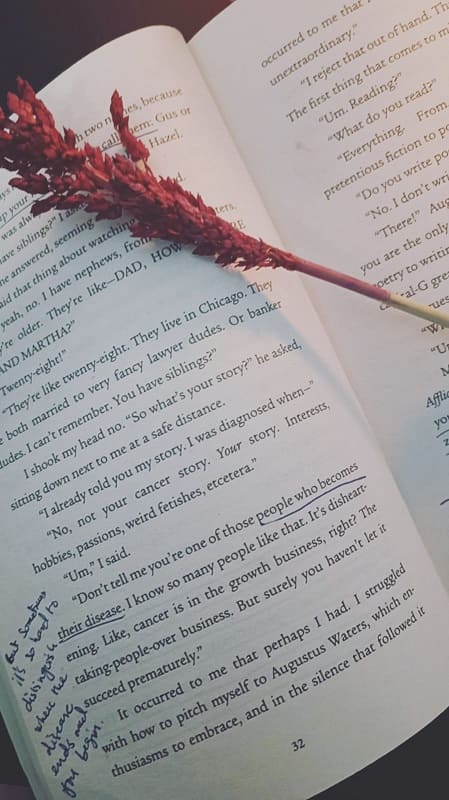Let’s get one thing straight before we deep-dive into the topic: books are sacred and need to be treated as such. And while looking at our topic, a lot of you might be thinking, “well, that’s oxymoronic,” we want you to hold on just a little longer to understand where we are coming from.
To you, maintaining the sanctity of a book could mean never marking it—and that’s okay.
But to many of us, a book that is loved is one we’ve interacted with and had conversations with. It has spoken to us, and we have spoken back to it. A book that is loved is alive with signs of having been read.
And if that’s not enough to convince you that it’s time your book started having personalities of their own, then read on ahead.
In this blog, we will:
- Explain what annotation is
- Tell you what annotated editions are
- Share with you tips on how to annotate for fun
What Is Book Annotation?
The process of annotating involves adding notes, remarks or highlights to a text as we read it. These notes can include anything, such as our ideas, feelings, and inquiries, and they can be written in any style we choose—from simple symbols to full phrases.
This kind of note-taking can aid us in remembering important details from any literature, be it a school textbook or a book we like.
Believe it or not, the practice of annotating books extends back centuries, despite the fact that writing within books has typically been prohibited and denigrated in recent years. The mid-15th century saw the first use of the word “annote,” which is derived from the Latin “ad” for “to” and “notare” for “to mark or note.”
Scholars, researchers, and students have long utilized annotation to interact with literature.
Something can be annotated by adding notes that serve as commentary or explanations on the issue at hand. Books (including fiction and nonfiction), poetry, essays, and even photographs may all be annotated. These annotations are often found in a text’s margins.
When readers annotate a book, they slow down and pay more attention to any places in the text where they could have questions, recognize symbols, or make comments.
What Does Annotating A Book Mean In Publishing?
A book’s published version that includes explanations, observations, and various notes is referred to as an annotated edition.
Different annotated book versions may be found that serve a range of functions. For instance, a small glossary of challenging terms for a particular age range could be included in an annotated children’s book. An annotated classic, however, may be created for literature students who want to delve a little further into the book.
The length and detail of an annotated edition exceed those of the original text.
The book includes footnotes, appendices, and descriptive essays both inside the text and at the conclusion. Some books containing annotations show them with the original text, while others assemble them toward the end. Additionally, there could be versions that use a hybrid format, which combines translations, summaries, and commentary.
Why Do Publishers Annotate Books?
Readers and students can benefit much from annotations. They not only encourage a better comprehension of the material but also foster critical thinking and creativity. Annotations serve as a strategy to meet a variety of educational demands.
Publishers may add notes to a book to express their opinions on the author’s method of telling the tale over time.
Usually, the supplemental material is quite innovative and explanatory. Older texts, for example, could have annotations to make cultural distinctions interesting to younger readers. Readers can interact and work together through annotations to have insightful discussions about the book.
Annotated editions provide helpful suggestions for analyzing different aspects of the work, ultimately fostering unusual viewpoints and critical reading of the text.
Additionally, annotations encourage readers to pose interesting and insightful questions and look for solutions both inside and outside the confines of the given book. Annotations support the growth of a passionate interaction between the author and readers in more ways than just casual reading.
What’s more, is that annotations help with pronunciation and explain historical references.
Let’s say a book is reissued after a long time. Book Publishers may, in this instance, include fresh material on developments in pop culture since the book’s initial release. This is especially helpful when a piece leaves readers ridden with confusion or doubts regarding its meaning or context.
Types and Examples of Annotations in Books
Now that you know what annotation means, it’s time to look at some types and examples to further your understanding. The three basic categories of annotations are:
Descriptive
These are broad thoughts and comments on a paragraph, usually summarizing a lengthy chapter or incident. It is sometimes referred to as an indicative annotation and may include a summary of each chapter or a description of the book’s subject matter.
This could be a:
- An outline of the book’s contents and an explanation of the key argument
- The major ideas are summarized; subjects or chapter names may be included.
Informative
Statements providing context are known as informative annotations or summative annotations. These annotations can include historical allusions, lost customs, quotations, definitions, explanations of archaic words, and so forth.
An enlightening annotation is objective and contains the books:
- Main idea
- List of evidence justifying their argument
- Results or a conclusion
Evaluative
Critical annotations, sometimes referred to as evaluative annotations, function more like analyses of the text. The chapters’ key concepts and story aspects are explored, and the evaluative annotations also provide illuminating questions and comments.
Experts may also decide to compare the book to other works of a similar genre, point out its advantages and disadvantages, provide their interpretations, and discuss any biases or writing styles that a casual reader would miss.
Here are some helpful things to think about:
- Contribution of the work to the literature on the subject
- How it contrasts with related works
- Author’s credentials for writing the piece and publisher authority
- Textual strengths and weaknesses
- Audience target and level of difficulty
You can also understand the different types of annotation based on style:
- The single-sentence annotated text: This generally serves as a “teaser,” giving the reader just enough information to know what the book is about.
- The annotated description: This offers the reader a broad overview of the content, summarizes each section of the book, and is devoid of judgment or opinion.
- The annotated critique: This material comprises details from a descriptive annotation and a critique or judgment about the source.
How to Annotate For Personal Reading
Although annotated editions of a book can be informative and fun to read, especially for those who’re always looking to learn beyond what a text offers, if you don’t want to opt for such a copy, you can always annotate a regular book yourself.
If you’re one of those people who consider marking books a cardinal sin—I used to be one of those too—this section can help you understand why some of us book lovers chose to join the dark side.
Why Should You Annotate Books?
Making annotations while reading actively helps readers absorb information in texts critically. By keeping track of our thoughts and reflections, we may more effectively interact with the information, spot key ideas, and themes, and even enhance our comprehension.
No matter if we are reading for fun or for school, there are several advantages to making notes. The following are a few of the most important:
It Aids In Information Processing
When we annotate, we interact with the text as we read it. As a consequence, we may fully activate our information processing system and immerse ourselves in learning. By processing information, the brain may more efficiently encode and store information for long-term storage.
You’ll comprehend the Book More Fully
Annotating is especially useful for texts that cover difficult or complex subjects or simply learning-based literature. By annotating, you can better grasp the characters, underlying themes, etc..
Key Points Are Easier To Find When Annotated
We execute a preliminary skim as part of the annotation process, emphasizing or underlining the key details and topics. This is especially useful when reading lengthy or complex material since it enables us to rapidly select and examine significant parts later when we re-read.
It Improves Your Memory
As a result of my annotations and notes on the fantasy novel Fury born, which I read more than three years ago, I can still recall what occurred in it. It significantly aids in retaining what happens in a book—especially if you’re reading it for academic purposes.
It Inspires Additional Investigation
We could have inquiries regarding the text as we read. Taking notes allows for a conversation with the material and promotes continued education. Annotation, according to research, can boost performance by increasing involvement.
It’s Simply Fun
The main reason I annotate books is for that. Yes, you can annotate books for your coursework or other purposes, but doing it for pleasure is different. You can jot down your silliest ideas, clever one-liners, or humorous remarks. No rules exist.
What to Annotate In a Book
If you’ve never annotated before, you could be looking at a page and thinking: but what do I mark?
And although there’s no science to annotating, certain things help you figure out what on the page can help you later.
Quotes
Any lines that you find to be particularly well written or that resonate with you. These can be mentioned in book reviews if you write them.
Symbolism
Even if you’re not entirely clear about what they imply yet, underline or highlight any symbols that repeatedly appear throughout the text. As you keep reading, this will assist you in drawing crucial connections and recognizing overarching themes.
Once more, even if you are unsure of the significance of these themes or symbols, you will at least have notes to remind you what you need to explore.
Passages That Have To Do With the Primary Storyline
This works well with books with many storylines or ones that go into great detail about a subject. Reading books like this, while fun, can be really hard to track. Here, annotating can help you keep track of the different characters and their experiences within the book—this is how I read Khaled Hosseini’s And the Mountains Echoed.
New Words
Any unfamiliar terms should be circled or highlighted so you can quickly locate them and check them later. Even while a single word may not appear to matter much, it might significantly impact how well you comprehend the passage’s major theme.
Connections With the Real World
Of course, you should also keep an eye out for any references to the outside world. Recognizing any political references the author may be making—whether to past or present events—will help you grasp their intended meaning.
How to Annotate Books
Starting out on my annotation journey, I had to contend with the question of how to go about it. Some methods are a little less invasive—don’t require you to actually mark your book permanently—than the others. And while they are what you can opt for going in, they aren’t the only—or even the best—way to annotate.
Here are some methods I love using:
Use Sticky Tabs for Books
I make an effort to limit the number of tabs I use since it might be challenging to remember which tab stands for what and if it is crucial for me to take note of. Generally, this is what sticky tabs can be used for:
- Well-written writing and quotations—this one should go without saying. Go ahead and mark it if you find something lovely or a quotation that really affected you because you want to remember it.
- Important details—this is a general term for a variety of things: Character initiation/development, narrative development, setting creation, and themes
For anything that requires longer thoughts, feel free to use “sticky notes books.”

Make Annotated Notes
Another traditional annotating technique. This is relatively in-depth since you have to express your ideas in writing and interact with the material.
You don’t have to write a lot to annotate in this way. Brief phrases or short sentences can also be used as comments. Smaller comments can be placed in the margins or immediately after the paragraph ends.
Use Highlighters for Books
Mark any lines that stand out as strong or poetic as you read; any dialogue that made you smile or chuckle. Highlight numerous lines or entire paragraphs if you want. There is nothing stopping you!
You can highlight them with various colors. Different connotations can be associated with different book highlighters and colors, such as green for excellent writing and yellow for essential data.
Underline Text
Underlining text that stands out to you can help you pay attention to what you’re reading and can even assist you in getting back to the parts you really like in a book. Personally, I feel that I really remember the story better when I interact with the book by underlining the important portions.
Book Annotation Color Key–Adding Sense To the Chaos
With all the highlighters, sticky tabs, and sticky tabs you’re using, it can get hard to remember which part of the book has something specific you liked and now want to revisit. If you don’t mind a little chaos like me, you can just leaf through the manuscript to find the good parts, but if you like to have everything neatly organized, you can color-coordinate your book annotation.
Red—this color can be used to highlight any romantic scenes in the book.
Orange—this color can indicate the parts of the book you don’t like.
Yellow—you can use this color to mark any heartwarming moments.
Green—this can be sections in the book that are well-written.
Blue—this can be used to mark sad parts.
Purple—you can use this color to highlight favorite quotes.
Or you may create your own method; make sure you have book tab packs with four or five different colors in each package. You can also match the sticky tabs to your colored pens and highlighters once you’ve allocated the colors to them.
So if you’re reading a novel and the characters have their first kiss, you may use a pink highlighter, a pink tab, or even a pink pen to jot down your thoughts. Ensure that you get pens that won’t bleed through the pages. Since books can contain different sorts of pages, I advise keeping a variety of pens on hand.
Final thoughts
Start off slowly if you’re new to annotation. Try out several annotation techniques on a single article or chapter. As you gain confidence, you may experiment with several strategies to see which ones suit you the most.
Annotating will become second nature with time and practice, and you’ll be able to make use of all the advantages of this potent learning tool.
You may become a more engaged reader and have a more enjoyable reading experience by making notes in a book. Whether you’re writing fiction or nonfiction, you’ll be compelled to take your time and pay attention to details that you would otherwise overlook.







